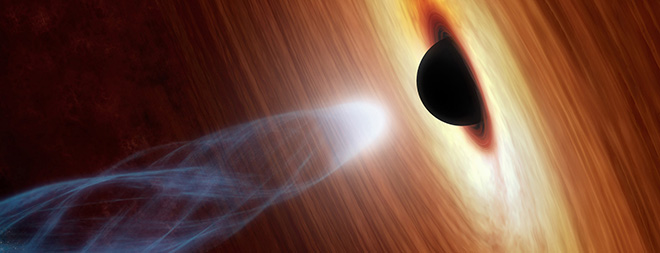Black Hole Cores May Not Be Infinitely Dense

Artist's concept of a supermassive black hole
NASA/JPL-Caltech
(ISNS) -- The cores of black holes may not hold points of infinite density as currently thought, but portals to elsewhere in the universe, theoretical physicists say.
A black hole possesses a gravitational field so powerful that not even light can escape. A black hole generally forms after a star dies in a titanic explosion known as a supernova, which crushes the remaining core into dense lumps.
A maddening enigma called a singularity -- a region of infinite density -- lies at the heart of each black hole, according to general relativity, the modern theory of gravity. The infinite nature of singularities means that space and time as we know them cease to exist there.
Scientists have long sought ways to avoid the complete breakdown of all the known laws of physics brought on by singularities. Now researchers suggest the centers of black holes may not hold singularities after all.
These new findings are based on loop quantum gravity, one of the leading theories seeking to unite quantum mechanics and general relativity into a single theory that can explain all the forces of the universe. In loop quantum gravity, the four dimensions of spacetime are composed of networks of intersecting loops — ripples of the gravitational field.
The researchers applied loop quantum gravity theory to the simplest model of black hole — a spherical, uncharged, non-rotating body known as a Schwarzschild black hole.
"We have been looking at various aspects of spherical models for several years," said researcher Jorge Pullin, a theoretical physicist at the Louisiana State University in Baton Rouge. "We like them because they are at the frontier of what is possible in loop quantum gravity today — a bit more complicated than the cosmologies that have been studied over the last decade, but not so complicated as to become intractable. An 'aha' moment was when we realized we can carry out an important simplification of the equations of the model."
Instead of a singularity, they found the center of this black hole only held a region of highly curved spacetime.
"This is a clean treatment of what happens inside a black hole, using a quantum theory of gravity," said theoretical physicist Carlo Rovelli at Aix-Marseille University in Marseille, France, who did not take part in this study. "It has long been expected that the singularities in the centers of black holes are cured by quantum gravity, and this is the conclusion that this work supports."
Theoretical physicists had previously shown that with loop quantum gravity, they could eliminate the singularity that past research suggested existed at the Big Bang. Instead of emerging from a point of infinite density, their work proposed the cosmos was born from a "Big Bounce," expanding outward after a prior universe collapsed.
"Perhaps in the future it can be shown that all singularities are removed by the theory," Pullin said.
Just as loop quantum gravity replaced the singularity at the Big Bang with a bridge to another universe, these new findings replace each singularity in black holes with "a bridge to another region in the future of our universe," Pullin said. Although prior studies also suggested black holes harbored such bridges, researchers had believed the singularities in black holes prevented any way of crossing those bridges.
"I think that this shows that loop quantum gravity is very vital and bubbling, and continues to produce exciting new results and new ideas," Rovelli said.
Pullin emphasized that they used a very simple model in this study, consisting of only highly curved spacetime without representing the actual matter found inside real black holes. The models for the study were also exactly spherically symmetrical, unlike many black holes, which spin and thus differ across their surfaces. Finally, in their model the black hole was there forever and will be there forever — in reality, black holes generally form after the collapse of stars and should one day evaporate away if they no longer have matter or energy to devour.
"Adding matter and having a black hole that evolves is what we are aiming for next," Pullin said.
Pullin and his colleague Rodolfo Gambini detailed their findings online May 23 in the journal Physical Review Letters.

